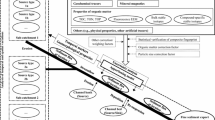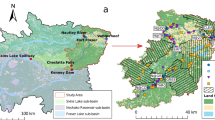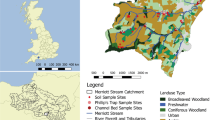Abstract
Purpose
Identifying of the sources, stores and pathways of sediments in a catchment is essential to accurately target management actions designed to reduce sediment delivery to receiving waters. Fingerprinting the source of sediment using geochemical properties has increasingly been accepted as an accurate approach for quantifying the contribution of different sources to river sediment discharge. In this study, we seek to examine the effect of particle size and location of the sources on their contribution to suspended sediments.
Materials and methods
Geochemical tracers (n = 41) were employed to calculate proportional contributions of sediment to Emu Creek, a predominantly pastoral catchment (911 km2) in south-eastern Queensland, Australia. The study focused on two high flow events (10- and 6-year return periods) and some lower flow events which occurred during the 18 months from October 2011 to March 2013. Source contributions were determined at eight spatially distributed sites in major tributaries and along the main channel of Emu Creek. Source determination at the in-stream sites was done using end member samples (based on the underlying rock type) collected upstream of the site of interest, thus indicating how different sources dominate at different locations downstream. To examine whether different size fractions shared similar provenances, three size fractions of both source and suspended samples including fine silt and clay (<10 μm), silt (10–63 μm) and fine sand (63–212 μm) were analysed.
Results and discussion
The source apportionment results using the distribution mixing model indicate that particle size and location of sources within a catchment are major factors that affect the measured contribution of sources to suspended sediments. The closer a suspended sediment sampling site is to a potential source, the more likely it is that source of sediment will dominate the material being sampled.
Conclusions
For all size fractions, proximal sources of sediment make a higher contribution to suspended sediments than distal sources. This indicates that management actions should be focused on the more proximal sources to the point of interest/impact. Although proximal soil sources were major contributor of sediments in all three size fractions, the percentage of contribution greatly vary in different size fractions, emphasising the need to trace the size fraction which is causing the downstream problems.









Similar content being viewed by others
References
Armstrong A, Quinton JN, Heng BCP, Chandler JH (2011) Variability of interrill erosion at low slopes. Earth Surf Process Landf 36:97–106
Bilotta GS, Brazier RE (2008) Understanding the influence of suspended solids on water quality and aquatic biota. Water Res 42:2849–2861
Blake WH, Ficken KJ, Taylor P, Russell MA, Walling DE (2012) Tracing crop-specific sediment sources in agricultural catchments. Geomorphology 139–140:322–329
Caitcheon GG, Douglas G, Palmer M (2006) Sediment source tracing in the Lake Burragorang catchment. CSIRO Land and Water, Canberra
Caitcheon GG, Olley JM, Pantus F, Hancock G, Leslie C (2012) The dominant erosion processes supplying fine sediment to three major rivers in tropical Australia, the Daly (NT), Mitchell (Qld) and Flinders (Qld) Rivers. Geomorphology 151–152:188–195
Collins AL, Walling DE (2002) Selecting fingerprint properties for discriminating potential suspended sediment sources in river basins. J Hydrol 261:218–244
Collins AL, Walling DE, Leeks GJL (1996) Composite fingerprinting of the spatial source of fluvial suspended sediment: a case study of the Exe and Severn river basins, United Kingdom. Géomorphol Relief Process Environ 2:41–53
Collins AL, Walling DE, Leeks GJL (1998) Use of composite fingerprints to determine the provenance of the contemporary suspended sediment load transported by rivers. Earth Surf Process Landf 23:31–52
Collins AL, Zhang Y, Walling DE, Grenfell SE, Smith P (2010) Tracing sediment loss from eroding farm tracks using a geochemical fingerprinting procedure combining local and genetic algorithm optimisation. Sci Total Environ 408:5461–5471
Collins AL, Zhang Y, Walling DE, Grenfell SE, Smith P, Grischeff J, Locke A, Sweetapple A, Brogden D (2012) Quantifying fine-grained sediment sources in the River Axe catchment, southwest England: application of a Monte Carlo numerical modelling framework incorporating local and genetic algorithm optimisation. Hydrol Process 26:1962–1983
Devereux OH, Prestegaard KL, Needelman BA, Gellis AC (2010) Suspended-sediment sources in an urban watershed, Northeast Branch Anacostia River, Maryland. Hydrol Process 24:1391–1403
Digital geological mapping data (2014) Queensland geology and structural framework GIS data. https://www.business.qld.gov.au/industry/mining/geoscience-data-information/geoscience-data-publications/digital-data/geological-mapping. Accessed Feb 2013
DNRM (2014) Department of Natural Resources and Mines. http://watermonitoring.dnrm.qld.gov.au. Accessed Jan 2014
Douglas G, Caitcheon G, Palmer M (2009) Sediment source identification and residence times in the Maroochy River estuary, southeast Queensland, Australia. Environ Geol 57:629–639
Evrard O, Navratil O, Ayrault S, Ahmadi M, Némery J, Legout C, Lefèvre I, Poirel A, Bonté P, Esteves M (2011) Combining suspended sediment monitoring and fingerprinting to determine the spatial origin of fine sediment in a mountainous river catchment. Earth Surf Process Landf 36:1072–1089
Evrard O, Poulenard J, Némery J, Ayrault S, Gratiot N, Duvert C, Prat C, Lefèvre I, Bonté P, Esteves M (2013) Tracing sediment sources in a tropical highland catchment of central Mexico by using conventional and alternative fingerprinting methods. Hydrol Process 27:911–922
Foster IDL, Boardman J, Keay-Bright J (2007) Sediment tracing and environmental history for two catchments, Karoo Uplands, South Africa. Geomorphology 90:126–143
Fox JF, Papanicolaou AN (2007) The use of carbon and nitrogen isotopes to study watershed erosion processes. J Am Water Resour Assoc 43:1047–1064
Fukuyama T, Onda Y, Gomi T, Yamamoto K, Kondo N, Miyata S, Kosugi KI, Mizugaki S, Tsubonuma N (2010) Quantifying the impact of forest management practice on the runoff of the surface-derived suspended sediment using fallout radionuclides. Hydrol Process 24:596–607
Haddadchi A, Ryder DS, Evrard O, Olley J (2013) Sediment fingerprinting in fluvial systems: review of tracers, sediment sources and mixing models. Int J Sediment Res 28:560–578
Haddadchi A, Olley J, Laceby P (2014) Accuracy of mixing models in predicting sediment source contributions. Sci Total Environ 497–498:139–152
Hairsine PB, Sander GC, Rose CW, Parlange J-Y, Hogarth WL, Lisle I, Rouhipour H (1999) Unsteady soil erosion due to rainfall impact: a model of sediment sorting on the hillslope. J Hydrol 220:115–128
Hughes AO, Olley JM, Croke JC, McKergow LA (2009) Sediment source changes over the last 250 years in a dry-tropical catchment, central Queensland, Australia. Geomorphology 104:262–275
Klages MG, Hsieh YP (1975) Suspended solids carried by the Gallatin River of southwestern Montana: II. Using mineralogy for inferring sources. J Environ Qual 4:68–73
Koiter AJ, Owens PN, Petticrew EL, Lobb DA (2013) The behavioural characteristics of sediment properties and their implications for sediment fingerprinting as an approach for identifying sediment sources in river basins. Earth Sci Rev 125:24–42
Laceby JP, Olley J (2015) An examination of geochemical modelling approaches to tracing sediment sources incorporating distribution mixing and elemental correlations. Hydrol Process 29:1669–1685
Lu H, Moran CJ, Prosser IP, DeRose R (2004) Investment prioritization based on broadscale spatial budgeting to meet downstream targets for suspended sediment loads. Water Resour Res 40:W09501
Martinez-Mena M, Alvarez Rogel J, Albaladejo J, Castillo VM (1999) Influence of vegetal cover on sediment particle size distribution in natural rainfall conditions in a semiarid environment. Catena 38:175–190
Minella JPG, Merten GH, Clarke RT (2004) Identification of sediment sources in a small rural drainage basin. In: Golosov V, Belyaev V, Walling DE (eds.), Sediment Transfer Through the Fluvial System. IAHS Publication No. 288, Wallingford, U. K.
Mukundan R, Radcliffe DE, Ritchie JC, Risse LM, McKinley RA (2010) Sediment fingerprinting to determine the source of suspended sediment in a southern Piedmont stream. J Environ Qual 39:1328–1337
Navratil O, Evrard O, Esteves M, Legout C, Ayrault S, Némery J, Mate-Marin A, Ahmadi M, Lefèvre I, Poirel A, Bonté P (2012) Temporal variability of suspended sediment sources in an alpine catchment combining river/rainfall monitoring and sediment fingerprinting. Earth Surf Process Landf 37:828–846
Olley JM, Caitcheon G (2000) Major element chemistry of sediments from the Darling–Barwon river and its tributaries: implications for sediment and phosphorus sources. Hydrol Process 14:1159–1175
Olley J, Brooks A, Spencer J, Pietsch T, Borombovits D (2013) Subsoil erosion dominates the supply of fine sediment to rivers draining into Princess Charlotte Bay, Australia. J Environ Radioact 124:121–129
Owens PN, Batalla RJ, Collins AJ, Gomez B, Hicks DM, Horowitz AJ, Kondolf GM, Marden M, Page MJ, Peacock DH, Petticrew EL, Salomons W, Trustrum NA (2005) Fine-grained sediment in river systems: environmental significance and management issues. River Res Appl 21:693–717
Parsons AJ (2012) How useful are catchment sediment budgets? Prog Phys Geogr 36:60–71
Phillips JM, Russell MA, Walling DE (2000) Time-integrated sampling of fluvial suspended sediment: a simple methodology for small catchments. Hydrol Process 14:2589–2602
Poulenard J, Legout C, Némery J, Bramorski J, Navratil O, Douchin A, Fanget B, Perrette Y, Evrard O, Esteves M (2012) Tracing sediment sources during floods using Diffuse Reflectance Infrared Fourier Transform Spectrometry (DRIFTS): a case study in a highly erosive mountainous catchment (Southern French Alps). J Hydrol 414–415:452–462
Prosser IP, Rutherfurd ID, Olley JM, Young WJ, Wallbrink PJ, Moran CJ (2001) Large-scale patterns of erosion and sediment transport in river networks, with examples from Australia. Mar Freshw Res 52:81–99
QLUMP (2014) Queensland Land use Mapping Program https://www.qld.gov.au/environment/land/vegetation/mapping/qlump/. Accessed Feb 2014
Schiettecatte W, Gabriels D, Cornelis WM, Hofman G (2008) Enrichment of organic carbon in sediment transport by interrill and rill erosion processes. Soil Sci Soc Am J 72:50–55
Smith TB, Owens PN (2014) Flume- and field-based evaluation of a time-integrated suspended sediment sampler for the analysis of sediment properties. Earth Surf Process Landf 39:1197–1207
Smith HG, Sheridan GJ, Nyman P, Child DP, Lane PNJ, Hotchkis MAC, Jacobsen GE (2012) Quantifying sources of fine sediment supplied to post-fire debris flows using fallout radionuclide tracers. Geomorphology 139–140:403–415
Wallbrink PJ (2004) Quantifying the erosion processes and land-uses which dominate fine sediment supply to Moreton Bay, Southeast Queensland, Australia. J Environ Radioact 76:67–80
Walling DE (1983) The sediment delivery problem. J Hydrol 65:209–237
Walling DE (2009) The impact of global change on erosion and sediment transport by rivers: current progress and future challenges. UNESCO-IHP The United Nations World Water Development Report 3. UNESCO, France
Wilkinson SN, Wallbrink PJ, Hancock GJ, Blake WH, Shakesby RA, Doerr SH (2009) Fallout radionuclide tracers identify a switch in sediment sources and transport-limited sediment yield following wildfire in a eucalypt forest. Geomorphology 110:140–151
Wilkinson SN, Hancock GJ, Bartley R, Hawdon AA, Keen RJ (2013) Using sediment tracing to assess processes and spatial patterns of erosion in grazed rangelands, Burdekin River basin, Australia. Agric Ecosyst Environ 180:90–102
Acknowledgments
This work was funded by the Queensland Bulk Water Supply trading as Seqwater and Griffith University. Tanya Ellison is thanked for help with the field work.
Author information
Authors and Affiliations
Corresponding author
Additional information
Responsible editor: Hugh Smith
Rights and permissions
About this article
Cite this article
Haddadchi, A., Olley, J. & Pietsch, T. Quantifying sources of suspended sediment in three size fractions. J Soils Sediments 15, 2086–2100 (2015). https://doi.org/10.1007/s11368-015-1196-1
Received:
Accepted:
Published:
Issue Date:
DOI: https://doi.org/10.1007/s11368-015-1196-1




